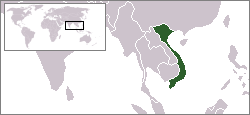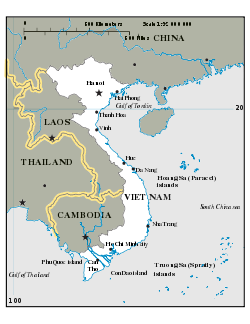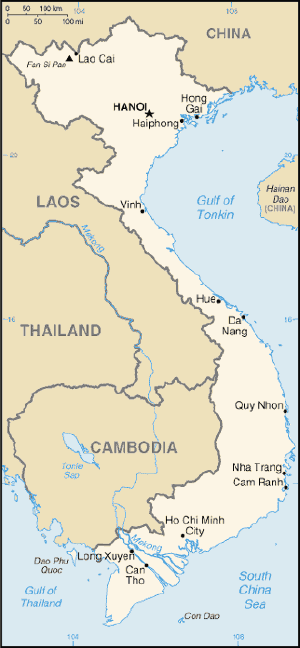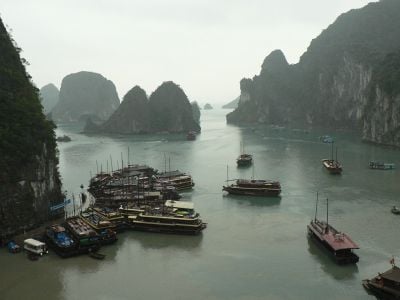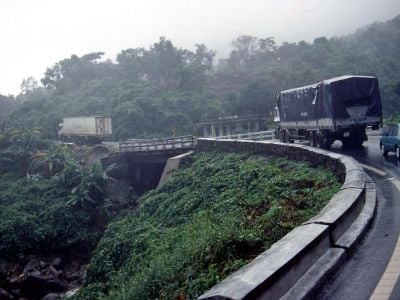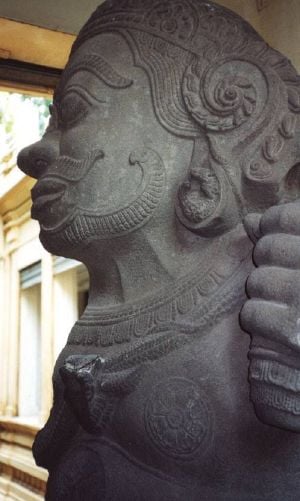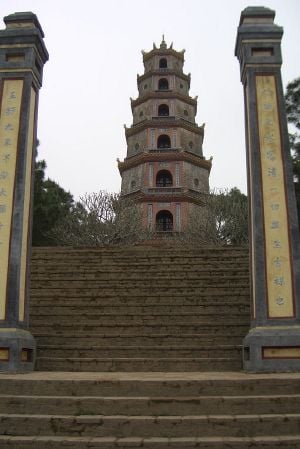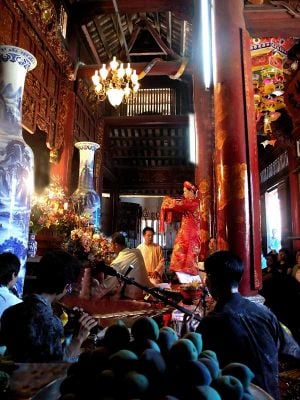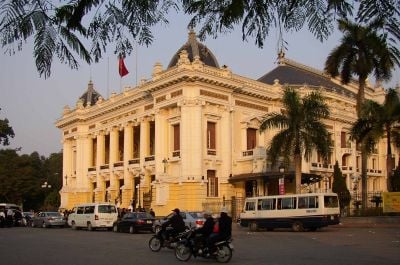Vietnam
| Cá»ng hòa Xã há»i chủ nghÄ©a Viá»t Nam Socialist Republic of Vietnam |
||||||
|---|---|---|---|---|---|---|
|
||||||
| Motto: Äá»c láºp â Tá»± do â Hạnh phúc "Independence â Freedom â Happiness" |
||||||
| Anthem: Tiến Quân Ca "The Song of the Marching Troops" (first verse) |
||||||
| Location of Vietnam (green)
|
||||||
| Capital | Hanoi | |||||
| Largest city | Ho Chi Minh City | |||||
| Official languages | Vietnamese | |||||
| Official scripts | Vietnamese alphabet | |||||
| Demonym | Vietnamese | |||||
| Government | Unitary socialist republic, Single-party state |
|||||
|  - | General Secretary | Tô Lâm | ||||
|  - | President | LÆ°Æ¡ng CÆ°á»ng | ||||
|  - | Prime Minister | Phạm Minh ChÃnh | ||||
|  - | National Assembly Chairman | Trần Thanh Mẫn | ||||
| Legislature | National Assembly of Vietnam | |||||
| Formation | ||||||
|  - | Äại Viá»t | 1054 | ||||
| Â -Â | French annexation | 1853 to 1883Â | ||||
| Â -Â | Independence from France | September 2, 1945Â | ||||
| Â -Â | Reunification | July 2, 1976[1]Â | ||||
| Â -Â | Current constitution | April 15, 1992Â | ||||
| Area | ||||||
|  - | Total | 331.698 km² (65th) 128,565 sq mi |
||||
|  - | Water (%) | 1.3 | ||||
| Population | ||||||
| Â -Â | 2023Â estimate | 100,300,000[2]Â (15th) | ||||
| Â -Â | 2019Â census | 96,208,984 [3]Â (15th) | ||||
|  - | Density | 298/km² (49th) 770/sq mi |
||||
| GDPÂ (PPP) | 2024Â estimate | |||||
| Â -Â | Total | |||||
| Â -Â | Per capita | |||||
| GDP (nominal) | 2024Â estimate | |||||
| Â -Â | Total | |||||
| Â -Â | Per capita | |||||
| Gini (2022) | 36.1[5] | |||||
| Currency | Äá»ng (â«) (VND) |
|||||
| Time zone | ICT (Indochina Time) UTC+7 (UTC+7) | |||||
|  - | Summer (DST) | No DST (UTC+7) | ||||
| Internet TLD | .vn | |||||
| Calling code | [[+84]] | |||||
| 1 | According to the official name and 1992 Constitution. | |||||
Vietnam officially the Socialist Republic of Vietnam is a nation in Southeast Asia. It borders the People's Republic of China to the north, Laos to the northwest, and Cambodia to the southwest. To the country's east lies the South China Sea. With a population close to 100 million, Vietnam is one of the most densely populated nations in Southeast Asia.
American involvement in the war between the communist North Vietnamese and anti-communist South Vietnamese from 1964 to 1975 brought Vietnam to the attention of the world. That war has been considered part of the Cold War and has been described as a "proxy war" between the United States and its Western allies on the side of the south Vietnamese, with the Soviet Union and the People's Republic of China supporting the north.
Geography
Vietnam covers an area of approximately 128,066 square miles (331,688 square kilometers), slightly bigger than New Mexico. Extending 1025 miles (1650km) north to south, the country is only 31 miles (50km) across at its narrowest point
The topography consists of hills and densely forested mountains, with level land covering no more than 20 percent. Mountains account for 40 percent of the area, with smaller hills accounting for 40 percent and tropical forests for 42 percent. The northern part of the country consists mostly of highlands and the Red River Delta.
Phan Xi PÄng, located in LÃ o Cai province, is the highest mountain in Vietnam at 10,312 feet (3143 meters).
The south is divided into coastal lowlands, the Annamite Chain (running northwest to southeast along the border with Laos), and extensive forests. Made up of five relatively flat plateaus of basaltic soils, the highlands account for 16 percent of the country's arable land and 22 percent of its total forested land.
The delta of the Red River (also known as the Sông Há»ng), is a flat, triangular region of 1158 square miles (3000 square kilometers). It is smaller but more intensely developed and more densely populated than the Mekong River Delta. Once an inlet of the Gulf of Tonkin, it has been filled in by alluvial deposits from rivers over tens of thousands of years, and it advances over 300 feet (one hundred meters) into the Gulf annually. The Mekong delta, covering about 15,400 square miles (40,000 square kilometers), is a low-level plain not more than 10 feet (three meters) above sea level and criss-crossed by a maze of canals and rivers. The delta advances 200 to 260 feet (60 to 80 meters) into the sea every year, as a result of sediment carried by the Mekong River.
Vietnam has a tropical monsoon climate, with humidity averaging 84 percent throughout the year. However, because of differences in latitude and topographical relief, the climate varies considerably from place to place. During the winter or dry season, extending from November to April, the monsoon winds blow from the northeast along the China coast and across the Gulf of Tonkin.
Temperatures range from a low of 41°F (5°C) in December and January, to more than 98°F (37°C) in April, the hottest month. Seasonal divisions are more marked in the northern half of the country.
Natural resources include: phosphates, coal, manganese, bauxite, chromate, offshore petroleum oil and gas deposits, forests, and hydropower. Natural hazards include: occasional typhoons (May to January) with extensive flooding.
The capital of Vietnam is Hanoi (it had served as the capital of North Vietnam), and the largest and most populous city is the Ho Chi Minh City (formerly known as Saigon).
History
A Vietnamese legend tells that the Vietnamese people of various tribes were born outside the womb following the marriage of Lạc Long Quân (Dragon Chief) and Ãu CÆ¡ (the Fairy). However, most Vietnamese historians consider the Dong Son civilization that covered much of Southeast Asia to be the beginning of Vietnam's history.
The Dong Son culture was a prehistoric Bronze age culture that was centered at the Red River Valley, but also flourished in other parts of the Indo-Malayan Archipelago from about 1000 B.C.E. to 1 B.C.E. The Dong Son people were skilled at cultivating rice, keeping water buffalo and pigs, fishing and sailing with long dug-out canoes. They also were skilled bronze casters, as can be seen in the famous Dong Son drums, which have been found widely in Southeast Asia. The Dong Son culture is linked to the Tibeto-Burman culture, the Dai culture in Yunnan and Laos, the Mon-Khmer cultures and the Tran-ninh's Plain of Jars plateau.
In 208 B.C.E., a Qin Dynasty general named Zhao Tuo established a state called Nam Viá»t which encompassed southern China and the Red River Delta. The historical significance of the original Nam Viá»t remains controversial because some historians consider it a Chinese occupation while others believe it was an independent era. For most of the period from 111 B.C.E. to the early tenth century C.E., Vietnam was under the rule of successive Chinese dynasties. Sporadic independence movements were attempted, but were quickly suppressed by Chinese forces.
In 939 C.E., the Vietnamese defeated Chinese forces at the Battle of Bach Dang River and gained independence, ending ten centuries of Chinese control. They gained complete autonomy a century later.
During the rule of the Tran Dynasty, Dai Viet defeated three Mongol invasions by the Yuan Dynasty. Incidentally, the final battle in which Vietnamese general Tran Hung Dao defeated most of Mongolian forces was held again at Bach Dang in 1288, like his ancestors nearly 300 years before.
Feudalism in Vietnam reached its zenith in the Le Dynasty of the fifteenth century, especially during the reign of Emperor Le Thanh Tong. Between the eleventh century and eighteenth centuries, the Vietnamese expanded south. They eventually conquered the kingdom of Champa and much of the Khmer Empire.
Vietnam's independence ended in the mid-nineteenth century, when the country was colonized by the French Empire. The French administration enacted significant political and cultural changes. A Western-style system of modern education was developed, and Christianity was introduced. Developing a plantation economy to promote the exports of tobacco, indigo, tea, and coffee, the French largely ignored increasing calls for self-government and civil rights. A nationalist political movement soon emerged, and its young leader, Ho Chi Minh, led its call for independence to the League of Nations. However, the French maintained control of their colonies until World War II, when the Japanese invaded Indochina. The Japanese exploited the natural resources of Vietnam for military campaigns into Burma, the Malay Peninsula, and India.
In the final years of the war, a nationalist insurgency emerged under Ho Chi Minh, committed to independence and communism. After the defeat of Japan, nationalist forces fought French colonial forces in the First Indochina War that lasted from 1945 to 1954. The French were defeated at the Battle of Dien Bien Phu and shortly afterward withdrew from the country. The Geneva Conference of 1954 divided the country at the seventeenth parallel into North and South Vietnam.
The United States opposed the division of the country and any alliance of communist-held North Vietnam to the Soviet Union or the People's Republic of China. Disagreements soon emerged over the organizing of elections and reunification, and the U.S. began increasing its contribution of military advisers even as Soviet-supplied arms and munitions strengthened communist forces. An alleged attack on U.S. ships in the Gulf of Tonkin on August 4, 1964, triggered a U.S. military assault on North Vietnamese military installations, launching the Vietnam War, that would escalate to the deployment of more than 500,000 troops into South Vietnam.
U.S. forces were soon embroiled in a vicious guerrilla war with the Viet Cong, the South Vietnamese communist insurgent militia. North Vietnamese forces unsuccessfully attempted to overrun the South during the 1968 Tet Offensive and the war soon spread into neighboring Laos and Cambodia. Under President Richard Nixon, the U.S. began transferring combat roles to the South Vietnamese military in a process known as "Vietnamization." The effort had mixed results, but with U.S. support the South Vietnamese were able to temporarily hold their own.
The Paris Peace Accords, on January 27, 1973, formally recognized the sovereignty of both sides. Under the terms of the accords, all American combat troops were withdrawn by March 29, 1973. Limited fighting continued, but all major fighting ended until the North once again invaded in strength and overpowered the South on April 30, 1975. One of the main impediments to furthering "Vietnamization" was the cutting off of all military funding to Vietnam by the US Congress and, perhaps more importantly, the resignation from office of Richard Nixon in August 1974. Nixon had attached his presidency to a pledge of "peace with honor." Seven and a half months after his resignation, Cambodia was taken over by the Khmer Rouge and South Vietnam fell to communists just two weeks later. Vietnamese citizens, as many as one and a half million known as the Vietnamese boat people, began to flee, but the United Nations estimated that perhaps one third died at sea.
South Vietnam briefly became the Republic of South Vietnam, a puppet state under military occupation by North Vietnam, before being officially reunited with the North under Communist rule as the Socialist Republic of Vietnam on July 2, 1976. Upon taking control, the Vietnamese communists banned other political parties, arrested suspects believed to have collaborated with the US, and embarked on a mass campaign of collectivization of farms and factories. Reconstruction of the war-ravaged country was slow, and serious humanitarian and economic problems confronted the communist regime. In 1978, the Vietnamese Army invaded Cambodia to remove their erstwhile allies, the Khmer Rouge, from power. This action worsened relations with China, which launched a brief incursion into northern Vietnam in 1979. This conflict caused Vietnam to rely even more heavily on Soviet economic and military aid.
In a historic shift in 1986, the Communist Party of Vietnam implemented free-market reforms known as Doi Moi ("Renovation"). With the authority of the state remaining unchallenged, private ownership of farms and companies, deregulation and foreign investment were encouraged. The economy of Vietnam has achieved rapid growth in agricultural and industrial production, construction and housing, exports and foreign investment. However, the power of the Communist Party of Vietnam over all aspects of government remains firm. In 1995 the United States restored diplomatic relations with Vietnam.
Politics
The Socialist Republic of Vietnam is a single-party state. A new state constitution, approved in 1992, replacing the 1975 version, reasserted the central role of the Communist Party in all aspects of government, politics, and society.
Only political organizations affiliated or endorsed by the Communist Party are permitted to contest elections. These include the Vietnamese Fatherland Front, workers, and trade unionist parties. Although the state remains officially committed to socialism as its defining structure, the ideology's importance has substantially diminished since the 1990s.
The President is the head of state and the nominal commander in chief of the military, chairing the Council on National Defense and Security. The Prime Minister is the head of government, presiding over a council of ministers composed of three deputy prime ministers and the heads of 26 ministries and commissions.
The National Assembly is a unicameral legislature composed of 498 members. It is superior to both the executive and judicial branches. All members of the council of ministers are derived from the National Assembly.
The Supreme People's Court of Vietnam, the highest court of appeal, is answerable to the National Assembly. Beneath the Supreme Court stand the provincial municipal courts and the local courts. Powerful military courts have special jurisdiction in matters of national security.
Most government appointees are members of the Communist Party, and the party's general secretary is one of the most important political leaders in the nation, controlling the party's national organization, state appointments, and setting policy. Vietnam is subdivided into 64 provinces, which are further subdivided into districts and municipalities. Provincial governments are expected to be subordinate to the central government.
The Vietnam People's Army is the official name for the three military services of Vietnam, which is organized on the lines of China's People's Liberation Army. The army is further subdivided into the Vietnamese People's Ground Forces (including Strategic Rear Forces and Border Defense Forces), the Vietnam People's Navy, the Vietnam People's Air Force, and the Coast Guard.
The 500,000-soldier army has been involved in Vietnam's workforce, in industry, agriculture, forestry, fishery, and telecommunications, to coordinate national defense and the economy. The government also organizes and maintains provincial militias and police forces. The role of the military in public life has steadily diminished since the 1980s.
Economy
Since the Vietnam War had destroyed much of the economy, upon taking power, the government created a command economy; farms, factories, and economic capital were collectivized, and millions of people were put to work in government programs.
Inefficiency and corruption in state programs, poor quality and underproduction, and restrictions on economic activities and trade plagued the economy for many decades. A trade embargo from the United States and most of Europe after the Vietnam War also hindered economic development. Trade with Communist bloc partners declined.
In 1986, the Sixth Party Congress introduced elements of market economy as part of a broad economic reform package called "doi moi" ("renovation"). Private ownership was encouraged in industries, commerce, and agriculture. Vietnam achieved a roughly 8 percent annual growth in gross domestic product from 1990 to 1997, and the economy continued to expand. Simultaneously, foreign investment grew three-fold and domestic savings quintupled. Manufacturing, information technology, and high-tech industries form a large and fast-growing part of the national economy.
Industrial output is evenly split between the state-owned, private, and foreign sectors. But corruption and an unclear legal system have limited Vietnam's ability to attract additional foreign investment since the 1997 Asian financial crisis. Vietnamese state-owned factories produce commodities for local consumption, including cigarettes, textiles, alcohol, fertilizer, cement, food, paper, glass, rubber, and some consumer appliances.
Vietnam has remained a relatively poor country, despite its rapid expansion.
As a result of land reform, Vietnam became the largest producer of cashew nuts with a one-third global share, and second-largest rice exporter in the world. Vietnam has the highest percent of land use for permanent crops of any nation in the greater Mekong sub-region. Other key exports are coffee, tea, rubber, and fishery products.
Export commodities included crude oil, marine products, rice, coffee, rubber, tea, garments, and shoes. Export partners include the United States, Japan, China, Australia, and Singapore.
Import commodities include machinery and equipment, petroleum products, fertilizer, steel products, raw cotton, grain, cement, and motorcycles. Import partners include China, Singapore, Taiwan, Japan, South Korea, and Thailand.
Agriculture's share of economic output has declined as production in other sectors of the economy has risen. Urban unemployment has been rising steadily due to high numbers of migration from the countryside to the cities, while rural unemployment is already at critical levels. Other measures taken to facilitate Vietnam's transition to a more market-oriented economy include updating its intellectual property legislation. Vietnam was accepted into the World Trade Organization in 2006.
Vietnam's modern transport network was developed under French rule for the purpose of harvesting raw materials, and was reconstructed after the Vietnam War. The railways are the most popular form of transport. Bicycles, motorcycles, and public bus services remain the dominant form of road transport in Vietnam's cities, towns, and villages. Traffic congestion is a serious problem in Hanoi and Ho Chi Minh City with the booming numbers of automobiles. There are also more than 10,500 miles (17,000 kilometers) of navigable waterways. The nation has seven ports at Cam Ranh, Da Nang, Hai Phong, Ho Chi Minh City, Hong Gai, Qui Nhon, and Nha Trang.
Demographics
The Vietnamese people originated in the area that is now southern China and northern Vietnam. They pushed southward over two millennia to occupy the entire eastern seacoast of the Indochina Peninsula, or a little less than half of current-day Vietnam. Ethnic Vietnamese, or Viet (known officially as Kinh), who make up 86 percent of the population, live in the lowlands and speak the Vietnamese language. A homogeneous social group, the Kinh exert influence on national life through their control of political and economic affairs and their role as purveyors of the dominant culture.
The government recognizes 54 ethnic groups. Ethnic minorities inhabit the least fertile lands, representing the majority of the country. The Muong, a closely related ethnic of the Kinh, the third largest minority group with an estimated population of around a million, are found mostly in the highlands that cover two-thirds of the national territory.
Vietnam's approximately one million ethnic Chinese, concentrated in southern Vietnam, constitute the second-largest minority group. Vietnamese of Chinese ancestry have been active in rice trading, milling, real estate, and banking in the south and shop-keeping, stevedoring, and mining in the north. Restrictions on economic activity following reunification in 1975 and the deterioration of relations with China reverberated through the Chinese-Vietnamese community. In 1978-1979, some 450,000 ethnic Chinese left by boat as refugees or were expelled across the land border with China. However in recent years, the government has encouraged overseas Hoa to return and invest.
The Khmer Krom are found in the delta of the Mekong River, in the south of Vietnam, where they are the majority of the rural population in many areas. They live in what was previously a part of Cambodia that Vietnam conquered in the seventeenth and eighteenth centuries.
The central highland peoples, commonly termed Degar or Montagnards (mountain people) comprise two main ethnolinguistic groups: Malayo-Polynesian and Mon-Khmer. About 30 groups of various cultures and dialects are spread over the highland territory. Other minority groups include the Cham, remnants of the once-mighty Champa Kingdom, conquered by the Vietnamese in the fifteenth century, the Hmong, and Thai.
Mahayana Buddhism, Daoism, and Confucianism have strongly influenced the religious and cultural life of the people, although the majority of Vietnamese people reportedly belong to 'no religion.' French colonists introduced Christianity. There remains a substantial following of Roman Catholicism and Protestantism amongst the Cao Dai and Hoa Hao communities. The largest Protestant churches are the Evangelical Church of Vietnam and the Montagnard Evangelical Church. Membership of Sunni and Bashi Islam is usually found in the ethnic Cham minority; there are also a few ethnic Vietnamese adherents of Islam in the southwest. The government has been criticized for its religion violations.
The socialist government does not recognize private land ownership, but since the early 1990s, the government has granted individuals long-term leaseholds, a trend reinforced with the passage of the 1998 Land Law. Control over land is contentious. The growth of a market economy has made land valuable. Cases of corrupt officials selling land-use rights or seizing land for personal use have been reported. Ambiguities in the law and the lack of clear legal processes make land disputes difficult to resolve.
Vietnamese revolutionary policies endorse gender equality, but the traditional pattern remains with women running the households, which entails cooking, cleaning, going to market, and caring for children, and men working in business, politics or government, or administration. Men also occupy the most prestigious religious roles of Buddhist monk or Catholic priest.
Almost all Vietnamese marry, usually in their late teens or early twenties. Arranged marriage and polygamy are illegal. Vietnamese prefer to marry someone of equal status, though it is better for the husband to be of slightly higher status. Divorce rates have increased, especially in urban areas. Many women are reluctant to divorce because remarriage is difficult.
The domestic unit commonly has two or three generations living together in one home. Residence is organized around the male line, and the eldest male exercises authority. Sons stay in the parent's home, and their brides move in with them. The eldest son will usually remain in the home.
Regarding languages, the majority of the population speak Vietnamese, part of the Austro-Asiatic language family. Vietnamese writing used Chinese characters until the thirteenth century, when the Vietnamese developed their own set of characters called Chu Nom. The celebrated epic The Tale of Kieu by Nguyen Du was written in Chu Nom. During the French colonial period, Quoc Ngu, several Portuguese missionaries romanized the Vietnamese alphabet, which brought literacy to the masses. The Vietnamese alphabet in use today is an adapted version of the Latin alphabet, with additional diacritics for tones and certain letters.
Other languages spoken by minority groups are: Tai, Muong, Khmer, Chinese, Nùng, and Hmong language. The French language, a legacy of colonial rule, is still spoken by some older Vietnamese as a second language. Russianâand to a lesser extent Czech or Polishâis often known among those whose families had ties with the Soviet bloc. Chinese, Japanese, and English have become the most popular foreign languages, with English study being obligatory in most schools.
Most people are poor. Wealth, particularly in urban areas where some individuals often with links to business or the government, have become wealthy, has stratified society. The possession of a motorcycle, a mobile phone, refrigerators, televisions, video players, gold jewelry, and imported luxury goods, such as clothing or liquor, symbolizes wealth. The poor ride bicycles, wear old tattered clothing, and live in traditional thatched homes.
Culture
Due to Vietnam's long association with China, Vietnamese culture remains strongly Confucian with its emphasis on familial duty. Education is highly valued. Historically, passing the imperial Mandarin exams was the only means for Vietnamese people to advance socially.
In the socialist era, Vietnamese cultural life was deeply influenced by government-controlled media and socialist programs. For decades, foreign cultural influences were shunned and emphasis placed on appreciating and sharing the culture of communist nations such as the Soviet Union, China, Cuba and others. Since the 1990s, Vietnam has seen a greater exposure to Southeast Asian, European, and American culture and media.
Vietnam has an extensive state-controlled network of schools, colleges, and universities. General education is imparted in five categories: pre-primary (kindergarten), primary schools, intermediate schools, high schools, and colleges. Courses are taught in Vietnamese. A large number of public schools have been organized to raise the national literacy rate. In 2004, 94 percent of the population over the age of 15 could read and write. There are a large number of specialty colleges, established to develop a diverse and skilled national workforce. A large number of Vietnam's most acclaimed universities are based in Ho Chi Minh City and Hanoi.
In 2007, the government was reforming Vietnam's education system to deal with out-of-date courses, a lecturer-centered method of teaching, research activities separated from teaching activities, a big gap between theory and practice that led to a large number of graduates being unable to find a job, and the fact that degrees from Vietnamese universities were not recognized worldwide.
The traditional female costume called "Ão dà i" is worn in special occasions such as weddings or Lunar New Year celebration or festivals. Ão Dà i was once worn by both genders but today is worn mainly by women.
Vietnamese cuisine uses very little oil and many vegetables. The main dishes are often based on rice, soy sauce, and fish sauce. Its characteristic flavors are sweet (sugar), spicy (serrano peppers), sour (lime), umami (fish sauce), and flavored by a variety of mint and basil.
Vietnamese music differs slightly among its three regions. Northern classical music is Vietnam's oldest and is, traditionally, more formal. Vietnamese classical music can be traced to the Mongol invasions, when the Vietnamese captured a Chinese opera troupe. Central Vietnam's classical music shows the influences of Champa culture with its melancholic melodies. Southern music exudes a lively laissez-faire attitude.
Football (soccer) is the most popular sport in Vietnam. Sports and games such as badminton, tennis, ping pong, and chess are popular with large segments of the population. Baseball, introduced during American presence in Vietnam, has gained some popularity. The (expatriate Vietnamese) community forms a prominent part of Vietnamese cultural life, exporting Western sports, films, music, and other cultural activities to the nation.
Vietnam is home to a small film industry, but films from its counterparts in Hong Kong, France, and the U.S. enjoy greater popularity and circulation.
The Voice of Vietnam is the official state-run radio broadcasting service that cover the nation. Vietnam Television is the sole state-run television broadcasting company. As Vietnam moved toward a free-market economy with its "doi moi" measures, the government has relied on the print media to keep the public informed about its policies. The measure has had the effect of almost doubling the numbers of newspapers and magazines since 1996. Vietnam is putting considerable effort into modernization and expansion of its telecommunication system, but its performance continues to lag behind that of its more modern neighbors.
Notes
- â Gerhard Robbers, Encyclopedia of World Constitutions (Facts on File, Inc., 2006, ISBN 978-0816060788).
- â Socio-economic situation in the fourth quarter and 2023 General Statistics Office of Vietnam. Retrieved November 9, 2024.
- â Completed Results of the 2019 Viet Nam Population and Housing Census Statistical Publishing House, 2020. Retrieved November 9, 2024.
- â 4.0 4.1 4.2 4.3 World Economic Outlook Database, April 2024 Edition. (Vietnam) International Monetary Fund. Retrieved November 9, 2024.
- â Vietnam: Gini inequality index The Global Economy. Retrieved November 9, 2024.
ReferencesISBN links support NWE through referral fees
- Dodd, Jan, and Mark Lewis. The Rough Guide to Vietnam, 5th ed. 2006. ISBN 1843536161
- Fredenburg, Peter, and Bob Hill (eds.). Sharing Rice for Peace and Prosperity in the Greater Mekong Subregion. Temple House Pty Limited, 2006.
- Herring, George C. America's Longest War: The United States and Vietnam, 1950-1975, 4th ed. New York: McGraw Hill, 2001. ISBN 0072536187
- Karrnow, Stanley. Vietnam: A History. Penguin, 1997. ISBN 0140265473
- McMahon, Robert J. Major Problems in the History of the Vietnam War: Documents and Essays, 3rd edition. New York: Houghton Mifflin, 2003. ISBN 061819312X
- Ray, Nick. Vietnam: Country Guide. Lonely Planet, 9th edition, 2007. ISBN 1741043069
- Robbers, Gerhard. Encyclopedia of World Constitutions. Facts on File, Inc., 2006. ISBN 978-0816060788.
- Tucker, Spencer (ed.). Encyclopedia of the Vietnam War. Oxford University Press, 2001. ISBN 0195135253
- Vo, Nghia M. Vietnamese Boat People, 1954 and 1975-1992. New York: McFarland & Company, 2005. ISBN 0786423455
External links
All links retrieved November 9, 2024.
- Vietnam country profile BBC.
- Vietnam CIA World Factbook.
- Vietnam Countries and Their Cultures.
Credits
New World Encyclopedia writers and editors rewrote and completed the Wikipedia article in accordance with New World Encyclopedia standards. This article abides by terms of the Creative Commons CC-by-sa 3.0 License (CC-by-sa), which may be used and disseminated with proper attribution. Credit is due under the terms of this license that can reference both the New World Encyclopedia contributors and the selfless volunteer contributors of the Wikimedia Foundation. To cite this article click here for a list of acceptable citing formats.The history of earlier contributions by wikipedians is accessible to researchers here:
The history of this article since it was imported to New World Encyclopedia:
Note: Some restrictions may apply to use of individual images which are separately licensed.


